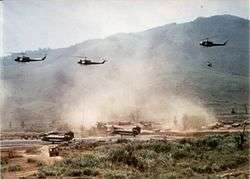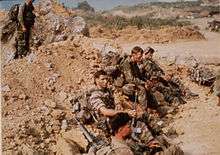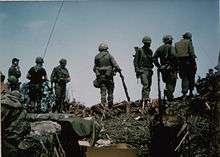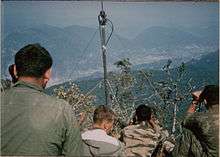Battle of Signal Hill Vietnam
The Battle of Signal Hill was a company size long-range penetration operation conducted in April 1968 during the Vietnam War. Signal Hill was the name given to the peak of Dong Re Lao Mountain, a densely forested 4,879-foot mountain north of A Luoi, a former French airfield midway in the A Shau Valley, bordering Laos. The strategic location made it an ideal communication and fire support site, vital to the success of Operation Delaware. The battle began at dawn, April 19, 1968, between long-range reconnaissance patrol members of the 1st Cavalry Division (Airmobile), Company E, 52nd Infantry (LRP), redesignated Company H, 75th Infantry (Ranger), and the North Vietnamese Army.[1]
Background

The North Vietnamese Army (NVA) gained control of the A Shau Valley in March 1966 after overrunning the last Special Forces camp in the area. They then fortified the valley with powerful crew-served 37mm antiaircraft cannons, some of them radar controlled. They also emplaced rapid firing twin-barreled 23mm cannons and many 12.7mm heavy machine guns to contribute to their air defenses. The A Shau Valley soon evolved into a major logistics depot for the NVA, with storage locations often located in underground bunkers and tunnels. Because of this strength on the ground, and the relative geographic isolation of the valley, the United States and its allies conducted little offensive activity in the area except for air attacks, and those were limited by the steep, mountainous terrain often cloaked under clouds, prone to sudden, violent changes in weather. In addition, because of the very limited air mobility of the Marines in I Corps Tactical Zone (ICTZ), no ground operations of any significance had been launched in the A Shau.[2][3]
By early April 1968, the NVA had just suffered two of their most significant defeats of the war: the Tet Offensive and Khe Sanh that cost them more than 42,000 men.[4] But the NVA still had the ability to regain the initiative in the northernmost part of South Vietnam, designated I Corps Tactical Zone (ICTZ). That ability came in part from isolated base areas like the sparsely populated A Shau Valley, running north-south along the Laotian border 30 miles south of Khe Sanh, where troops and supplies were moved into South Vietnam as the NVA prepared for another battle—at a time and place of its choosing. The A Shau, a mile-wide bottomland flanked by densely forested 5,000-foot mountains, was bisected lengthwise by Route 548, a hard-crusted dirt road. A branch of the Ho Chi Minh Trail, the valley was a key NVA sanctuary.[2][5][6]
Battle
In January 1968 General Creighton W. Abrams, deputy commander of U.S. forces in South Vietnam, ordered the 1st Cavalry Division (Airmobile) to move north from the Central Highlands to support the Marines.[7] The 1st Cavalry Division, an airmobile division with 20,000 men and nearly 450 helicopters, had the most firepower and mobility of any division-size unit in Vietnam.[8] When it arrived in I Corps Tactical Zone (ICTZ), the 1st Cavalry Division fought toe-to-toe with the enemy during Tet. It was fully engaged with the NVA at Khe Sanh when its commander, Maj. Gen. John J. Tolson, was ordered to prepare plans for the massive air assault into the A Shau Valley: Operation Delaware.[9][10][11]
Two brigades—about 11,000 men and 300 helicopters—would attack the north end of the 25-mile-long valley and leapfrog their way south, while another brigade would stay at Khe Sanh, providing security from the combat base to the Laotian border.[12] The operation required a radio relay site so the engaged brigades could communicate with Camp Evans near the coast or with approaching aircraft. On the eastern side, midway up the valley, was a perfect spot: the 4,878-foot Dong Re Lao Mountain. The 1st Cavalry Division's headquarters dubbed it “Signal Hill.”[1][13]

Since the mission required specially trained and equipped men who could rappel from helicopters, clear a landing zone with explosives, and hold the ground far from artillery support, the division's long-range reconnaissance patrol (LRRP, or “Lurp”) unit was the logical choice.[14] As a result, the mission to secure Signal Hill would first fall to Lt. Joseph Dilger’s 2nd Platoon, Company E, 52nd Infantry (LRP).[1][15][16]
As evening approached, April 9, 1968, Sgt. Doug Parkinson’s six-man Lurp team scrambled aboard a UH-1 Huey. They had just climbed Dong Tri Mountain outside the Marine combat base at Khe Sanh in search of the enemy. Although they never saw the enemy, a stray artillery shell nearly killed them all, a Bengal tiger stalked them at night, and they almost fell 1,000 feet to their deaths as helicopters hurriedly extracted them on long emergency ropes known as McGuire rigs. But Parkinson’s long-range reconnaissance patrol team from Company E, 52nd Infantry, commanded by Cpt. Michael Gooding, would soon find itself in the thick of one of the most daring airmobile operations of the Vietnam War: an air assault into the A Shau Valley. Company E would play a key role in establishing a stronghold in the valley—and it would pay a high price.[2]
Friday, April 19, dawned calm and sunny, and the assault operation began. The 30-man Lurp platoon gathered with several engineers and signalmen at Camp Evans, awaiting flights to Signal Hill, 19 miles away. Five UH-1 helicopters (known as "slicks" based on their transport role) from the 227th Assault Helicopter Battalion provided transportation for the strike force. With every unit requesting lift ships, many of which were undergoing repair or still at Khe Sanh, not enough helicopters were available to bring in the entire platoon, so Sgt. Parkinson’s team was told to wait for a second lift. The helicopters landed, and everyone else clambered aboard, heavily laden with gear. The slicks rose into a clear blue sky and vanished in the west, reaching the mile-high peak of Signal Hill some 20 minutes later.[1]

As planned, the small force of helicopters came to a hover 100 feet above the dense jungle, and the men, led by Lt. Dilger, started rappelling down to clear a landing zone. But in the thinner atmosphere at that altitude, the helicopter engines had less oxygen for power, and the rotors less air to bite into for lift. As a result, seconds after Sgt. Larry Curtis and his team leader, Cpl. Bill Hand, had jumped off the skids, their helicopter lost control while they were still 50 feet in the air.[1]
Curtis and Hand slammed into the ground but managed to get free of their rappel devices and roll out of the helicopter’s path as it careened through the canopy and crashed to the jungle floor. The impact knocked the crew and the remaining men on board unconscious. Curtis suffered a concussion and was pinned under a skid when the helicopter rolled on its side. As he struggled to get free, the chopper’s engine revved at full throttle and started leaking fuel. Despite the initial chaos, Lieutenant Dilger had a critical mission to complete, and he ordered those still rappelling in to retrieve the crates of explosives and gear being slung down and then establish a defensive perimeter around the peak.[1]
Once unloaded, the four helicopters still in the air quickly sped away to avoid further engine strain, and Cpl. Hand and the others could mount a belated rescue. After digging Sergeant Curtis out from beneath the skid and moving the injured to safety, they began the grueling task of clearing an LZ, using chain saws and long tubular explosives called bangalore torpedoes. The insertion and clearing work had not gone unnoticed, and soon NVA elements began moving toward the LRRP position.[1]
By the next morning there still wasn’t an adequate clearing for a helicopter to land, so the injured Sgt. Curtis had to be lifted out on a McGuire rig. As the assault force worked to clear an LZ, NVA soldiers moved up from the valley floor, reaching the mountaintop at noon. Hidden by dense foliage and scattered debris, and with their approach masked by the noise of explosives and chain saws, they were able to close on the perimeter, shooting at the members of Dilger’s platoon still struggling to make a suitable LZ.[1]
Unable to see the snipers, the assault force threw grenades down the slope and fired their weapons at suspected targets, keeping the enemy at bay. As the battle dragged on, a casualty collection point was established at the top of the peak in the shelter of a bomb crater. The seriously wounded were given plasma expanders to replace lost blood, cloth-wrapped plastic bandages to cover sucking chest wounds, or morphine injections to ease the pain. The assault force made repeated calls to Camp Evans for helicopters to evacuate the wounded, but with two brigades making airmobile assaults far north into the valley, and helicopter losses reaching more than a dozen shot down on the first day of the operation, none were available for Signal Hill.[1]

By late afternoon a functional LZ was finally cleared, but at a steep cost. Snipers had killed Cpl. Dick Turbitt and Pfc. Bob Noto, mortally wounded Sgt. William Lambert and combat engineer Pfc. James MacManus, and wounded Cpl. Roy Beer with a burst through the legs and arm, and Lt. Dilger was shot through the chest and close to death.[1]
As fierce battles raged far to the north in the valley, Sgt. Lambert—just one day short of completing his two-year tour--clung to life for six hours before dying in the arms of his comrades. Soon after Lambert died, a lone Huey approached from the north to remove the wounded and the stranded aircrew left on Signal Hill.[2]
Next morning
Early the next morning, Sunday, April 21, a medevac, already loaded with wounded infantrymen and the badly burned pilot of a downed helicopter, landed on Signal Hill to pick up Cpl. Hand, whose condition had worsened. He was put inside on a stretcher, beneath the screaming burned pilot. Soon after the medevac departed, Cpt. Gooding and Sergeant Parkinson’s six-man team arrived as other reinforcements flew en route. Since no sweeps had been made to clear the peak of snipers, Cpt. Gooding ordered Parkinson to make an immediate patrol around the peak. Once Parkinson had notified everyone on the LZ about their planned route of departure his team moved out through the mud to the western side of the mountain. There they found the crashed helicopter, lying on its side on a steep embankment. Then, stepping over an enemy fighting position where cartridges and two grenades had been abandoned in pouches, they pushed through a dense wall of mud-covered branches and trees, twisted and broken from the demolitions operations used to clear the LZ.[1]
Once through the thick mat of debris, they entered dense virgin forest swathed in a thick blanket of fog—the clouds surrounding the peak. Bracing their feet on tree roots and the stems of huge ferns, they groped from stalk to frond to keep their balance, slowly maneuvering through the fog and undergrowth that limited their visibility to the men immediately in front of and behind them. After an hour of this slow, painstaking, and uneventful climb, a lone NVA soldier stood and called to Parkinson’s front scout—an indigenous Montagnard named Dish—thinking he was a fellow soldier. Instantly realizing his mistake, the soldier stood shocked, arms at his sides, mouth and eyes open, as Dish and Parkinson raised their rifles and shot him.[1]

Parkinson’s team made another patrol around the peak while, with the LZ now operational, hundreds of scout helicopters, slicks, gunships, and powerful CH-47 Chinooks laden with troops flocked in from the east. Reaching the Lurps’ mountaintop stronghold, they plunged deep inside the valley to search out and destroy the enemy with airpower and overwhelming infantry assaults. As large and small battles raged farther and farther south, streams of tracers could be seen flying skyward. The effectiveness of the enemy antiaircraft was obvious as massive CH-54 Skycranes could be seen from Signal Hill, returning to Camp Evans with one or two destroyed helicopters slung beneath them.[1]
During the operation, jet air strikes came frequently. In clear weather they struck the valley and mountainside positions, at times screaming in just above the Lurps’ heads. Their bombs, along with the shells from the vast rings of artillery, shortly transformed the lush, green valley and mountainsides into a continuous wasteland of craters. Watching it all from their mountaintop position, the Lurps could see for miles in the cool, thin air, from the distant warships 30 miles east in the South China Sea to pristine towering green mountains in neutral Laos seven miles away, where silvery cataracts tumbled down cloud-wreathed cliffs.[1]
B-52 Arc Light strikes were launched several times each night. Cells of three bombers would approach north along the valley at 30,000 feet, with each aircraft carrying 84 500-pound bombs inside the fuselage, and 24 750-pounders beneath the wings. The bombers could easily be identified by their running lights, V formation, and the faint drone of their engines, but by the time that identification could register, it was too late for the enemy to run. When the bombers reached the valley, the clouds below the Lurps’ mountaintop position suddenly started flashing bright orange as three lines of bombs merged to lay down a continuous swath of death and destruction that raced down the valley at five hundred miles an hour. In seconds the earth trembled beneath the Lurps’ feet, followed after a long lag by a deep rumbling that sounded as if the valley itself were moaning in agony.[1]
In the following days, Signal Hill was secured. A battery of artillery was airlifted on top to support the infantry in the valley, and another helicopter crashed on the peak, its rotors narrowly missing two Lurps; however, one soldier was fatally crushed beneath the skid. Another soldier was slammed in the chest by a sailing fuel can, and another man, an air force meteorologist, had his leg and feet severed off.[1]
Aftermath
The Lurps held that small green islet high above a vast ocean of clouds for close to three weeks, providing a vital fire support base and radio relay site for the troops in the valley to communicate with Camp Evans and with approaching aircraft. Their action saved American lives and helped ensure the success of Operation Delaware by allowing coordinated air and ground attacks, timely artillery strikes, and air rescues of wounded infantrymen and downed aircrews.[2]

Despite hundreds of B-52 and jet air strikes to destroy the most sophisticated enemy antiaircraft network yet seen in South Vietnam, the NVA managed to shoot down a C-130, a CH-54 Skycrane, two CH-47 Chinooks, and nearly two dozen UH-1 Hueys. Many more, though not shot out of the sky, were lost in accidents or damaged by ground fire. The 1st Cavalry Division suffered more than 130 dead and 530 wounded in Operation Delaware. Bad weather aggravated the loss by causing delays in troop movements, allowing a substantial number of NVA to escape to safety in Laos. Still, the NVA lost more than 800 dead, a tank, 70 trucks, two bulldozers, 30 flamethrowers, thousands of rifles and machine guns, and dozens of antiaircraft cannons. They also lost tons of ammunition, explosives, medical supplies, foodstuffs, and documents.[1][17]
A week after leaving A Shau, Sgt. Parkinson’s assistant team leader, Cpl. Bob Whitten, was killed in action. Three other Lurps from the Signal Hill assault force were also killed, and Sergeant Curtis lost an eye in a grenade blast. In the following days, Sgt. Parkinson returned home, Lt. Dilger recovered from his wounds and became a member of the Special Forces, Cpt. Gooding was promoted to major and assigned to Special Warfare Command, and Company E, 52nd Infantry (LRP), was redesignated H Company, 75th Infantry (Ranger).[2]
Maj. Gen. John J. Tolson, in summing up the weather's impact on his division’s airmobile operations, said, “According to the long range forecast based on old French records, April was supposed to have been the best month for weather in the A Shau Valley. As it turned out, May would have been a far better month––but you don’t win them all.”[18] That lesson, however, would not be lost on the 101st Airborne Division, who, in May 1969, stormed Dong Ap Bia Mountain, commonly known as Hamburger Hill, on the opposite side of the valley, southwest of Signal Hill. The NVA lost that battle, too, yet they returned to A Shau, prompting criticism of American tactics. But with South Vietnam’s wild and remote borders over twice as long as the trenches in France during World War I—which were manned by millions of troops—there simply were not enough allied soldiers to secure them. With that limitation in mind, airmobile divisions such as the 1st Cavalry and 101st Airborne demonstrated that a unit need not be based in the hinterlands to operate and destroy the enemy there.[2][19]
The 1st Cav would end the Vietnam War by suffering more casualties than any other army division: 5,444 killed in action and 26,592 wounded in action.[1] However, the First Marine Division suffered 7,012 men killed in action and the Third Marine Division suffered 6,869 men killed in action.[20]
See also
References
- 1 2 3 4 5 6 7 8 9 10 11 12 13 14 15 16 17 18 Robert C. Ankony, Lurps: A Ranger's Diary of Tet, Khe Sanh, A Shau, and Quang Tri, revised ed., Rowman & Littlefield Publishing Group, Lanham, MD (2009), pp.157–72.
- 1 2 3 4 5 6 7 Robert C. Ankony, "No Peace in the Valley," Vietnam magazine, Oct. 2008, pp. 26–31.
- ↑ Shelby L. Stanton, Anatomy of a Division: The 1st Cav in Vietnam. Novato, CA: Presidio Press (1987), pp.143–49.
- ↑ Robert Pisor, The End of the Line: The Siege of Khe Sanh. New York: W. W. Norton (1982), p. 181.
- ↑ Gen. William C. Westmoreland, A Soldier Reports, Garden City, NY: Doubleday (1976), pp. 347–49.
- ↑ Lt. Gen. John J. Tolson, Vietnam Studies: Airmobility 1961–71, Department of the Army, Washington, D.C. (1973) pp. 182–92.
- ↑ Shelby L. Stanton, Anatomy of a Division: The 1st Cav in Vietnam. Novato, CA: Presidio Press (1987), p.111.
- ↑ Shelby L. Stanton, Anatomy of a Division: The 1st Cav in Vietnam. Novato, CA: Presidio Press (1987), p. 42 & 209.
- ↑ Lt. Gen. John J. Tolson, Vietnam Studies: Airmobilty 1961–1971, Department of the Army, Washington, D.C., (1973), p.178.
- ↑ Gen. William C. Westmoreland, A Soldier Reports, Garden City, NY: Doubleday, (1976), p.347.
- ↑ Roberts, E.B. Maj., Gen. The First Air Cavalry Division Vietnam: August 1965 to December 1969, Nippon Printing Co., Tokyo, Japan (1970): pp. 44-51 and 258-59.
- ↑ Lt. Gen. John J. Tolson, Vietnam Studies: Airmobilty 1961–1971, Department of the Army, Washington, D.C., (1973), p.185.
- ↑ Shelby L. Stanton, Anatomy of a Division: The 1st Cav in Vietnam. Novato, CA: Presidio Press (1987), p.144-46.
- ↑ Shelby L. Stanton, Anatomy of a Division: The 1st Cav in Vietnam. Novato, CA: Presidio Press (1987), pp. 145–46.
- ↑ Gen. William C. Westmoreland, A Soldier Reports, Garden City, NY: Doubleday, (1976), p.347.
- ↑ Roberts, E.B. Maj., Gen. The First Air Cavalry Division Vietnam: August 1965 to December 1969, Nippon Printing Co., Tokyo, Japan (1970): pp. 196-97 and 257.
- ↑ Shelby L. Stanton, Anatomy of a Division: The 1st Cav in Vietnam, Presidio Press, Novato, CA (1987), p.148-49.
- ↑ Lt. Gen. John J. Tolson, Vietnam Studies: Airmobility 1961–1971. Washington, DC: United States Government Printing Office (1973), p. 192.
- ↑ Lt. Gen. John J. Tolson, Vietnam Studies: Airmobility 1961–1971. Washington, DC: United States Government Printing Office (1973).
- ↑ CDR Kenneth Davis, US Navy (ret), and associates of the Coffelt Database of Vietnam casualties.
Further reading
- Rangers at War, Shelby L. Stanton, Ivy Books: New York (1992).
- Vietnam Studies: Airmobility 1961–71, Lt. Gen. John J. Tolson, Department of the Army, Washington, D.C. (1973).
External links